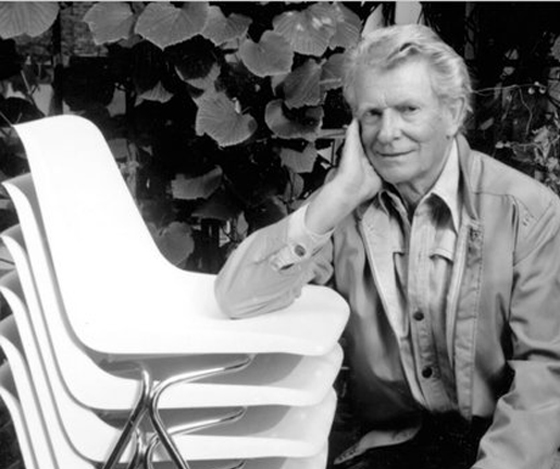Robin Day: 1915–2010
Texte par Simon Keane-Cowell
Zürich, Suisse
21.12.10
Robin Day, one of Britain's greatest designers, whose illustrious career spanned seven decades, dies at the age of 95
In these digital times, to receive a personal letter is somewhat of a treat. To receive one from Robin Day, one of the most prolific and celebrated designers in British design history, is epistolary heaven.
Having written to the legendary furniture designer a couple of years ago to ask him for his recollections of Ernest Race, whose 1951 Festival of Britain chair designs I was researching at the time, I was delighted when a reply arrived in the post. It began with an apology: 'My memory isn't as good as it once was,' wrote Day, who was already 92 at the time. Such self-deprecation was typical of the man, whose gentleness dovetailed with his very human take on modernism.
Celebrated British designer Robin Day, who died in November 2010, aged 95, pictured with his famous polypropylene stacking chairs

Celebrated British designer Robin Day, who died in November 2010, aged 95, pictured with his famous polypropylene stacking chairs
×One half of the star-designer couple 'the Days' (his wife, Lucienne, who sadly passed away earlier this year, was a renowned textile designer), Robin Day helped shape the material landscape of post-war Britain with designs that were considered resolutely modern without being rarified, and democratic. His 1963 'Polypropylene Chair', one of the best-selling pieces of furniture worldwide, was for many years a staple in, among other places, schools, church halls and doctors' surgeries. My own school days began at the age of four with me sitting down in a London classroom on a scaled-down version of the robust, injection-moulded chair.
What makes the designer's career all the more remarkable, however, is its length. Day was still active into his nineties, receiving commissions from leading British furniture brands SCP and twentytwentyone, as well as from Italian manufacturer Magis. Eschewing the vicissitudes of fashion, Day's adherence to a singular design expression – one characterised by a certain visual economy, yet possessing a warmth – regardless of whether it was 'in' or not, can be seen as much in this later work as in his classics from the 1950s and 60s.
The story of 20th-century British design without Robin Day would be a far less richer one. To read a more detailed account of his contribution to this narrative, here's a link to his obituary in The Guardian newspaper:
.....
